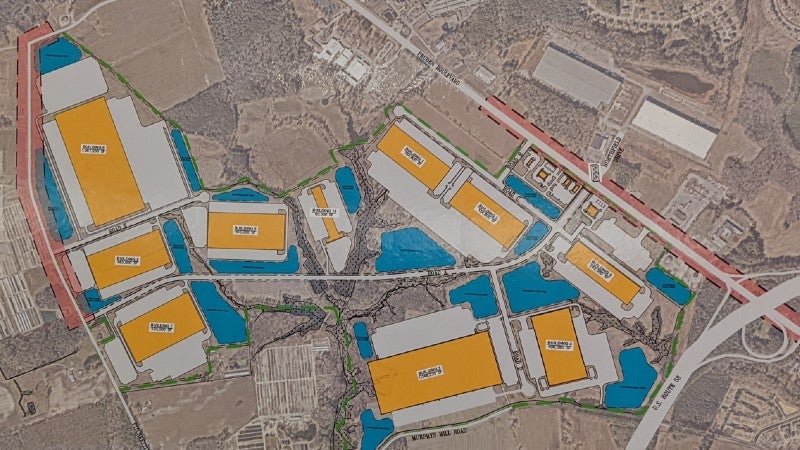Port 460 project would provide ample warehouse space, but raises traffic, stormwater concerns
Published 8:20 pm Wednesday, June 8, 2022

- The Port 460 Logistics Center is proposed to be 545 acres and host close to 5 million square feet of warehouse space in what has been designated as a foreign trade zone service area.
|
Getting your Trinity Audio player ready...
|
Officials for a company looking to acquire and have more than 500 acres off U.S. Route 58 and Pruden Boulevard rezoned say it is needed as the Port of Virginia continues to grow, but the rezoning faces a long process amid resident concerns.
The Port 460 Logistics Center, as it would be called, is proposed to be 510 acres and host close to 5 million square feet of warehouse space in what has been designated as a foreign trade zone service area, which is located in or near customs and border protection ports of entry and is the U.S. version of a free-trade zone. Much of the property, except for about 30 acres that fronts Pruden Boulevard, would need to be rezoned from general commercial to industrial.
“This market has seen tremendous growth over the last couple of years,” said Brian Morris, a development manager with Matan Companies, a real estate company based in Frederick, Maryland. “And just given what’s happening at the Port (of Virginia) and their expansion, there’s a need for this type of space. That’s what we’re targeting.”
Dave France, a project manager with Kimley Horn who has drawn up conceptual plans for the project, said the project is somewhat comparable to the Virginia Port Logistics Park off Route 58, with both yielding about 5 million square feet of space.
A conceptual site plan for the proposed Port 460 Logistics Center designates nine separate sites within the property, ranging from 23 to 93 acres, to be used for various warehouses or light-industrial buildings, with the front of the property off of Pruden Boulevard, also known as U.S. Route 460, to be used for commercial businesses. The property also borders a small part of Kings Fork Road, Pitchkettle Road and Murphys Mill Road.
“They’re pretty close comparisons between them,” France said. “The difference on 58 is there are also several other developments out there. … So there’s a little more pressure out there than there is here, but the port needs product, and if the city would like to capture what the port, the state and all of us that are members of the community have invested in, they should consider having places like this to invest their dollars.”
France said the Suffolk property is one of just a few in Hampton Roads that could be developed in the manner wanted by Matan. The company’s purchase of the property is contingent upon approved rezoning by City Council.
“Suffolk is one of those host communities that can take advantage of it. … Working with the port, all the investment, the billions of dollars that the port has put into making the shipping channels deeper, adding capacity at the port, the commonwealth would do well to support that,” France said.
He said that while traffic was the most significant concern among the more than 50 people who turned out for the June 3 public meeting, others raised issues with the permitting process and stormwater management, but called those “not significant concerns.”
The project is currently undergoing review through the Land Use Committee through the city’s office of Planning and Community Development. It will issue a formal report that will be issued to the Planning Commission and City Council prior to public hearings both bodies will eventually hold on the rezoning request.
“We don’t know exactly when that’s going to happen because we’re still working with the Land Use Committee to go through this,” Morris said. “This is part of the process, having a public meeting.”
France, in answering a question from a city resident about the project, noted that Port of Virginia officials “are well aware of what we’re doing.” He said the earliest any shovel would go in the ground is about a year after council rezoning approval.
“What I think you’re seeing here, and whether you like it or not, it’s just kind of a thing,” France said. “I mean, as a community, you can prevent it from happening, right? City Council can say, ‘Nope, don’t do this,’ and it goes away. But because of what the port’s doing, and because of what we are all doing as consumers — we just invested I-don’t-know how many billions of dollars in deepening our channels and expanding the Port (of Virginia) — there’s a ton more capacity coming in.
“Geopolitically, there’s something interesting going on, where, because of the stuff going on in China, there’s actually a change in where goods are being manufactured. It’s going more Malaysian and sort of shifting around. The shipping routes for that are drifting towards no longer being favored to go into LA/Long Beach (ports). They’re actually favoring the East Coast ports, and so we’re getting this geopolitical shift of goods that are coming to the East Coast of the United States coming through the Suez (Canal). … Those big forces are creating the demand with developers.”
Morris said city planners are reviewing the company’s traffic study, which calls for creating turn lanes into the site, and noted the possibility of reconfiguring the interchange around routes 58 and 460 in the future.
“We see this as a big job creation (project) — up to 9,000 jobs potentially,” Morris said, “and a lot of tax revenue for the state and the city.”






